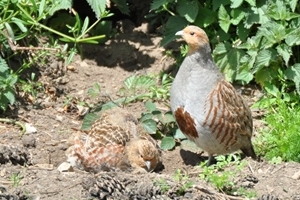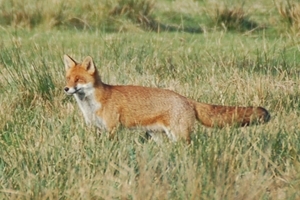Key findings
- Predator control significantly increased the proportion of partridges that breed successfully and the average size of their broods, thus substantially improving the production of young.
- Partridge breeding stocks were significantly increased following seasons of predator control, despite shooting, which accounted for roughly 25% of autumn density.
- The experiment showed that common predator species play a key role in limiting production and subsequent breeding density of partridges.
 The Salisbury Plain Study was a landmark study into the impact of predation on the breeding success and population density of grey partridges, conducted by the Game Conservancy between 1984 and 1990.
The Salisbury Plain Study was a landmark study into the impact of predation on the breeding success and population density of grey partridges, conducted by the Game Conservancy between 1984 and 1990.
Prior to the Salisbury Plain Study, there had been a near-absence of serious studies into the effects of predation on breeding densities and breeding success, leading to a dramatic underestimation of its impact. There was widespread distaste for the damaging impact of Victorian and Edwardian gamekeepers on the status of predatory birds and mammals in Britain, and an eager acceptance of the university teaching that prey numbers determined predator numbers, not vice versa. Those who did concede an impact of predation argued that it affected only the harvestable surplus, not population trends.
However, studies conducted in Sussex during the 1970s suggested that, on farms where predation was not reduced in summer, hen and nest survival was very low. Population models using these data suggested a potentially large influence of predation on population trends. The Salisbury Plain Study was designed to test this experimentally. To make its results unequivocal it involved two study areas and a ‘switchover’ design. Predator control was switched from one area to the other after three years, so that comparisons were possible between the two areas in the same years, and for the same area between years.
Two areas, Milston and Collingbourne, were selected on the Ministry of Defence training area on Salisbury Plain. These were similar in size (around 5km2), featured comparable amounts of farmland and unenclosed downland, and hosted partridge populations of similar size. The sites were separated by 6km. No habitat changes took place during the experiment.
At the beginning of the study, one baseline season (1984) was allowed where the existing partial control of predators on both areas persisted. Then, from 1985 and 1987 inclusive, a gamekeeper was employed to run an intensive spring and summer predator control campaign on the Collingbourne site. Milston was left totally unmanaged. Between 1988 and 1990, the gamekeeper was switched to Milston, leaving Collingbourne to return to a ‘natural’ state. Finally, partridge numbers were monitored in 1991 but there was no predator control on either site; in this year the fates of partridge nesting attempts on both sites were documented using radio-tagged birds.
Table 1: Annual partridge stocks from 1984 to 1990 (bold denotes intensive predator control in effect).
| Year |
Total birds |
Number shot |
| Collingbourne |
|
|
| 1984 |
213 |
65 |
| 1985 |
311 |
116 |
| 1986 |
372 |
135 |
| 1987 |
318 |
27 |
| 1988 |
184 |
47 |
| 1989 |
112 |
21 |
| 1990 |
128 |
25 |
| |
|
|
| Milston |
|
|
| 1984 |
233 |
22 |
| 1985 |
200 |
11 |
| 1986 |
182 |
16 |
| 1987 |
79 |
1 |
| 1988 |
189 |
19 |
| 1989 |
295 |
35 |
| 1990 |
399 |
105 |
 The most important effect was the number of pairs that successfully raised a brood: when predation control began in each area the success rate almost doubled in one case and trebled in the other. When predation control ceased at Collingbourne after the switch, breeding success dropped to less than 40% of the previous year. Additionally, average brood size was always larger under predation control, because first clutches, which are generally larger than subsequent attempts in a season, were more likely to be successful. Spring breeding stocks in years following predation control were 36% larger than in those without, while stocks following seasons without predation control fell by an average of 24%, leading to a 2.6-fold difference in breeding density after three years.
The most important effect was the number of pairs that successfully raised a brood: when predation control began in each area the success rate almost doubled in one case and trebled in the other. When predation control ceased at Collingbourne after the switch, breeding success dropped to less than 40% of the previous year. Additionally, average brood size was always larger under predation control, because first clutches, which are generally larger than subsequent attempts in a season, were more likely to be successful. Spring breeding stocks in years following predation control were 36% larger than in those without, while stocks following seasons without predation control fell by an average of 24%, leading to a 2.6-fold difference in breeding density after three years.
The Salisbury Plain Study was a significant piece of research, presenting very strong evidence for the importance of summer predation to grey partridge populations. Additionally, the results were achieved through predator control within the law, demonstrating that permitted techniques for the control of common predator species were effective without resorting to persecution on the scale pursued by Victorian and Edwardian gamekeepers.
The Salisbury Plain Study showed that native predators at ordinary densities were suppressing the density of a native gamebird species, irrespective of shooting interests. Gamekeeping methods were effective to combat this, allowing the partridge population to increase. Although indicative, this study alone does not allow generalisation to other prey species or other landscapes. A later experimental study at Otterburn showed benefits of predator control for red grouse and upland wading birds, and benefits for brown hares have also been shown. The effectiveness of predator control in general to suppress predator numbers must not be taken for granted, either, and that is the subject of current research by the GWCT.
Further reading
- Tapper, S.C., Potts, G.R., & Brockless, M.H. (1996). The effect of an experimental reduction in predation pressure on the breeding success and population density of grey partridges Perdix perdix. Journal of Applied Ecology, 33: 965-978.
- Fletcher, K., Aebischer, N. J., Baines, D., Foster, R. and Hoodless, A. N. (2010), Changes in breeding success and abundance of ground-nesting moorland birds in relation to the experimental deployment of legal predator control. Journal of Applied Ecology, 47: 263–272.
- Reynolds, J.C., Stoate, C., Brockless, M.H., Aebischer, N.J., & Tapper, S.C. (2010). The consequences of predator control for brown hares (Lepus europaeus) on UK farmland. European Journal of Widllife Research, 56: 541-549.